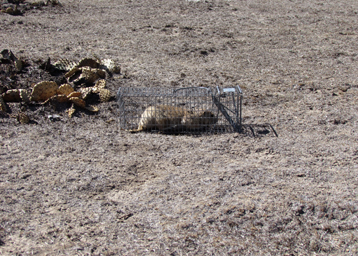Status and Distribution of Black-tailed Prairie Dogs on Small Cultural National Parks in the Western Great Plains

Dr. Jack Cully
Rachel Pigg, M.S. Student
Project Supervisor:
Dr. Jack Cully
Location:
Kansas, Colorado, Nebraska
Status:
Began summer 2008
Funding:
U.S. Geological Survey Cooperators
Dr. Gary Willson
Dr. Pamela Benjamin
Completion:
December 2011
Objectives:
Identify status of black-tailed prairie dogs at 4 culture parks in western Great Plains.
Document rate of migrationDocument population trends.
Identify damage by prairie dogs to park resources.
Progress and Results:
Black-tailed prairie dogs pose a management dilemma for land managers because the species is considered an agricultural pest by many farmers and ranchers at the same time it is identified as a keystone species and ecological engineer that benefits many grassland plant and animal species. On Park Service lands, prairie dogs may also degrade cultural resources by digging burrows into cultural remains that the Parks are mandated to protect. This project, which will begin in spring 2008, will address four issues at four parks in the western Great Plains, Fort Larned National Historic Site, Kansas, Bent's Old Fort, Colorado, Sand Creek Massacre National Historic Site, Colorado, and Scott's Bluff National Monument, Nebraska: 1. What is the status of prairie dogs on four small prairie culture parks? 2. Are current population assessment methods adequate? 3. What is the extent of prairie dog movement from National Park lands to adjacent farm or ranch lands? 4. What is the extent of prairie dog damage to the parks' cultural resources?
Products:
Cully, J., R. Pigg, and A. Goldberg. 2010. Sustainability of black-tailed prairie dogs at small culture parks of the western Great Plains. 22nd North American Prairie Conference, Cedar Falls, Iowa.
Pigg, R., T. Johnson, and J. F. Cully. The influence of landscape features on the disease ecology of sylvatic plague. Fifth Biennial Meeting of the International Biogeographical Society, 7-11 January 2011. Crete.
Pigg, R., T. Johnson, and J. F. Cully. The influence of landscape features on the disease ecology of sylvatic plague. 72nd Midwest Fish and Wildlife Conference, Des Moines, Iowa, 4-7 December 4-7, 2011.
Pigg, RM, AR Goldberg, DE Biggins, JF Cully, Jr. 2013. Local scale movement of a highly social grassland mammal: insights from field observations. Biology Graduate Student Research Forum, Kansas State University, Manhattan, KS.
Pigg, RM, TL Johnson, JF Cully, Jr. 2012. Using circuit theory to model disease transmission among black-tailed prairie dog colonies. Biology Graduate Student Research Forum, Kansas State University, Manhattan, KS.